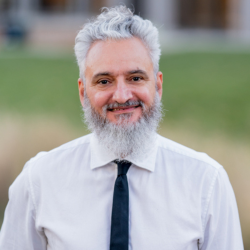The Brown School is formally launching the People, Health and Place Unit (PHP), a hub for cutting-edge research, coursework, and capacity-building centered on the intersection of healthy places and healthy people. The unit, headquartered at the school’s Prevention Research Center, brings together experts in health and place research, which will be featured in the unit’s kick-off event at 12 p.m. February 8, a symposium and panel discussion that is the first in this year’s Public Health Speaker Series: “People, Health and Place: Building Capacity and Evidence on the Health Impacts of Built and Social Environments in Latin America.”
Development of the PHP Unit, years in the making, began in earnest last year, within Washington University’s Prevention Research Center.

“We have been cooking this concept for three years with our longtime collaborators and kicked it off internally last spring,” said the unit’s Co-Director, Rodrigo Reis, professor and interim co-dean of the Brown School.
Reis said the work of PHP will directly connect with the equity, public health and climate goals of new strategic plans developed by both Washington University and the Brown School. It will also play a key role in the development of a new School of Public Health, an initiative the university announced last year.
The unit’s co-director is Deborah Salvo, formerly of the Brown School and now an associate professor at the University of Texas at Austin. Salvo led a recent project to study Forest Park in St. Louis and its impact on public health, one of the projects that is part of the unit’s research portfolio. “We’ve started to set things in place for the People, Health and Place Unit, and now we’re ready to show this to the world,” she said.
Salvo said the unit’s work will involve research, coursework and teaching at WashU, and local and global capacity building efforts. “The theme of what we do is health and place research,” she said. “We’re about team science and expanding the science and the message of how places matter in health.”
The PHP unit at the PRC/Brown School is leading the development of a global research group centered on the intersection of health and place work. As such, it is acting as the St. Louis based hub, and leading group, for an International People, Health and Place Research Group, which includes additional hubs/units in Austin, TX (led by Salvo), Mexico (led by Alejandra Jauregui – one of the panelists for the Public Health Speaker series event on Feb 8), and Brazil (led by Akira Hino – the other panelist for the Public Health Speaker series event on Feb 8). In terms of the International PHP Research Group, for which the WashU PHP unit is a leading actor, Reis said: “Right now, we’re primarily focusing on Latin America and Latino populations in the U.S., but we do plan to expand.”
“Our previous experiences working with global networks researching the impact of elements of the built environment, such as housing and transportation, on public health shows that this type of work is important to the U.S., where the struggles and challenges are quite similar to those we see in developing countries,” he added.
Current highlights of the ongoing work taking place at the WashU PHP unit include:
- Adapting, revising and hosting an updated version of the Built Environment Assessment Training (BEAT) Institute, a formal, online training program to be used in academic courses, in partnership with professor Karen Glanz, of the University of Pennsylvania, and original director of the BEAT Institute.
- Formalized partnerships with other researchers to create an international network, with whom Memorandums of Understanding have been executed. The network is now composed of colleagues in the U.S., Brazil, and Mexico. “When you look at health and place, changes like those in climate are most affecting developing countries,” Salvo said.
- Supporting the Global Observatory of Healthy and Sustainable Cities (GOHSC) and its 1000 Cities Challenge. The unit sponsored the development of the website for a new global surveillance system that tracks how well cities are being designed for, or have policies in place for health and sustainability. Salvo and Reis are both investigators of this initiative, in addition to being website sponsors. GOHSC currently has data for 25 cities in all inhabited continents of the world, and is seeking to expand its work to over 1000 global cities, through what they have denominated the 1000 Cities Challenge, which the PHP Unit supports.
The unit currently employs three students, including Ana Luiza Favarao Leao, a visiting Fulbright Scholar and doctoral student at the Urban Planning & Architecture Program at the State University of Londrina, Brazil. Her dissertation is about urban walkability and streetscapes, a good fit with the PHP’s work measuring qualities of the built environment for policy planning.
“It’s been a great, constructive experience,” she said of her work so far. “I’ve met so many experienced researchers in the built environment and public health, with a strong focus on global health, which I hadn’t experienced before.”
Áine O’Connor, who manages the unit with a focus on research, said she especially appreciates PHP’s niche, which focuses on the intersection of place and space and health, both globally and locally. “It’s a unique place for a public health unit to sit, and it has a focus on health equity,” she said. “One of the most exciting parts for me is the ability to see research that affects a lot of different places, with a global scale of impact. Our international, transdisciplinary partnerships mean we’re building capacity in a number of countries and our projects are going to be dedicated to the local community well-being. Our scope is very local and very global at the same time.”
O’Connor said the PHP’s long-term plan is to expand its development of capacity building and research efforts. “We plan to gain more partners and take this team science to different countries and continents, anywhere the built environment is of interest to researchers and practitioners,” she said.
She added that the unit’s far-flung leadership – she’s working from Dublin, Ireland, while the co-directors are in St. Louis and Texas – is appropriate for its mission. “I guess we’re attempting to practice what we preach!” she said.
